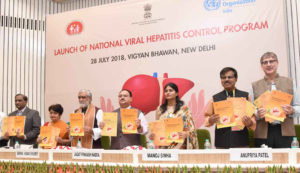Union Minister of Health and Family Welfare, Shri J P Nadda on July 28, 2018 launched the National Viral Hepatitis Control Program to mark the World Hepatitis Day, 2018. As per the Union Minister, with this initiative, Government is strongly committed to work towards elimination of viral hepatitis by 2030
- Shri J P Nadda also released the Operational Guidelines for National Viral Hepatitis Control Program, National Laboratory Guidelines for Viral Hepatitis Testing and National Guidelines for Diagnosis and Management of Viral Hepatitis.
National Viral Hepatitis Control Program
- MoHFW has launched the ‘National Viral Hepatitis Control Program’, with the goal of ending viral hepatitis as a public health threat by 2030 in the country.
- The aim of the initiative is to reduce morbidity and mortality due to viral hepatitis.
- The key strategies include preventive and promotive interventions with focus on awareness generation, safe injection practices and socio-cultural practices, sanitation and hygiene, safe drinking water supply, infection control and immunization; co-ordination and collaboration with different Ministries and departments; increasing access to testing and management of viral hepatitis; promoting diagnosis and providing treatment support for patients of hepatitis B &C through standardized testing and management protocols with focus on treatment of hepatitis B and C; building capacities at national, state, district levels and sub-district level up to Primary Health Centres (PHC) and health and wellness centres such that the program can be scaled up till the lowest level of the healthcare facility in a phased manner.
World Hepatitis Day 2018
- Every year WHO observes 28 July as World Hepatitis Day.
- WHO focused on the theme: “Test. Treat. Hepatitis” for World Hepatitis Day 2018
- As per the WHO, viral hepatitis B and C are major health challenges, affecting 325 million people globally. They are root causes of liver cancer, leading to 1.34 million deaths every year.
- Hepatitis B and C are chronic infections that may not show symptoms for a long period, sometimes years or decades.
- At least 60% of liver cancer cases are due to late testing and treatment of viral hepatitis B and C. Low coverage of testing and treatment is the most important gap to be addressed in order to achieve the global elimination goals by 2030.


